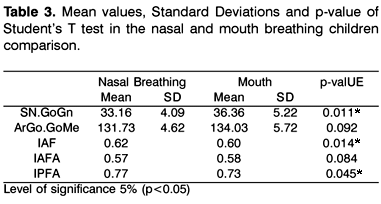AIM: the aim of this study was to evaluate the differences in facial proportions of nose and mouth breathing children using cephalometric analysis. STUDY DESIGN: transversal cohort. MATERIAL AND METHOD: Sixty cephalometric radiographs from pediatric patients aged 6 to 10 years were used. After otorhinolaryngological evaluation, patients were divided into two groups: Group I, with mouth breathing children and group II, with nose breathers. Standard lateral cephalometric radiographs were obtained to evaluate facial proportions using the following measures: SN.GoGn, ArGo.GoMe, N-Me, N-ANS, ANS-Me and S-Go; and the following indexes: PFH-AFH ratio: S-Go/N-Me; LFH-AFH ratio: ANS-Me/N-Me and UFH-LFH ratio: N-ANS/ANS-Me. RESULTS: It was observed that the measurements for the inclination of the mandibular plane (SN.GoGn) in mouth breathing children were statistically higher than those in nasal breathing children. The posterior facial height was statistically smaller than the anterior one in mouth breathing children (PFH-AFH ratio). Thus, the upper anterior facial height was statistically smaller than the lower facial height (UFH-LFH ratio). CONCLUSION: We concluded that mouth breathing children tend to have higher mandibular inclination and more vertical growth. These findings support the influence of the breathing mode in craniofacial development.
craniofacial development; mouth breathers; facial height




